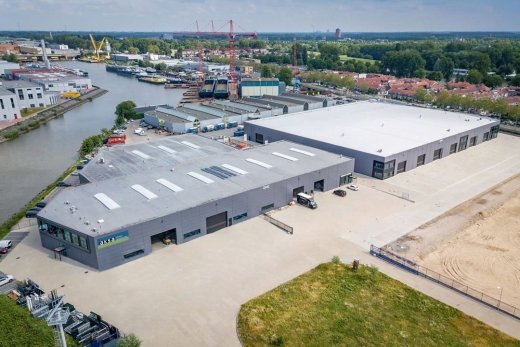What is an Automatic Transfer Switch (ATS)?
An Automatic Transfer Switch (ATS) is a crucial component in backup power systems, designed to seamlessly switch the power source from the main electrical grid to a backup generator during an outage. This process ensures that essential operations remain uninterrupted, preventing downtime in industrial, commercial, and residential applications.
ATS systems come in different configurations, including open transition, closed transition, and delayed transition models, each offering varying levels of power reliability and efficiency.
How Does an ATS Work?
The ATS continuously monitors the primary power source. When a failure is detected, it signals the backup generator to start. Once the generator reaches optimal performance, the ATS transfers the electrical load to the generator. When normal power is restored, the ATS switches back to the grid and turns off the generator, ensuring a smooth power transition.
How an ATS Works Optimally with Diesel Generators
For an ATS and a diesel generator to function seamlessly together, they must be properly sized, installed, and maintained. Here are key factors to ensure optimal performance:
- Proper Rating: The ATS must match the generator’s voltage, frequency, and load capacity. It’s also important to account for inrush current and motor loads to avoid overloading the system.
- Fast Switching Capability: High-quality ATS units can detect power loss within milliseconds and immediately trigger the diesel generator to start.
- Built-in Delay Timers: These timers prevent unnecessary generator starts due to short-term voltage drops and allow the generator to warm up and cool down properly.
- Regular Maintenance: Both the ATS and diesel generator should undergo scheduled maintenance. This includes checking relays, contacts, and control software, as well as verifying cable integrity and secure connections.
When properly configured, an ATS and diesel generator combo provides a highly reliable and efficient backup power solution for any critical operation.
Types of Automatic Transfer Switches
Open Transition ATS
This type of ATS momentarily disconnects from the power supply before switching to the backup generator. While cost-effective, it results in a brief power gap.
Closed Transition ATS
A closed transition ATS overlaps both power sources during switching, ensuring no power interruption. It is ideal for critical applications requiring uninterrupted power supply.
Delayed Transition ATS
Designed for sensitive electrical systems, this ATS introduces a short delay between switching, allowing equipment to safely power down before transitioning.
Soft Load Transfer ATS
This ATS gradually shifts the load from one source to another, preventing voltage fluctuations and ensuring a smoother transition.
Key Benefits of an Automatic Transfer Switch
Seamless Power Continuity
An ATS detects power failures instantly and automatically switches to the backup generator without requiring manual intervention. This prevents operational disruptions in critical facilities such as hospitals, data centers, and manufacturing plants.
Enhanced Safety
By automating power transfers, an ATS eliminates the risks associated with manual switching, reducing the chances of electrical faults, equipment damage, and operator errors.
Improved Equipment Protection
Fluctuations in power supply can harm sensitive electrical systems. ATS systems are designed to provide a smooth transition between power sources, preventing voltage fluctuations and ensuring equipment longevity.
Operational Efficiency
With automatic functionality, businesses can focus on their core operations rather than worrying about power failures. ATS systems enhance productivity by maintaining a reliable power supply at all times.
Remote Monitoring and Smart Features
Modern ATS models come equipped with remote monitoring capabilities, allowing users to track performance, receive alerts, and troubleshoot issues in real-time.
Common Challenges of Using an ATS
Compatibility Issues
Not all ATS models are suitable for every power setup. Businesses must choose an ATS that matches their generator capacity and electrical infrastructure.
Maintenance Requirements
Regular maintenance is essential to ensure the ATS functions correctly when needed. Dust accumulation, wiring faults, or software malfunctions can impact performance if not addressed.
Initial Installation Costs
While an ATS provides long-term value, the upfront investment can be significant. However, the cost is justified by the protection it offers against power-related disruptions.
Response Time Variability
Depending on the ATS type, some models have a brief delay before switching power sources, which may impact operations requiring immediate backup power. Closed transition switches can help minimize this lag.
How to Choose the Right ATS for Your Needs
Assess Your Power Requirements
Evaluate the total load your generator needs to support to ensure the ATS can handle the required capacity.
Consider the Transfer Type
- Open transition ATS: Standard and cost-effective but has a brief power gap.
- Closed transition ATS: Provides a seamless switch with no power interruption.
- Delayed transition ATS: Designed for systems requiring a controlled shutdown before switching.
- Soft load transfer ATS: Ideal for preventing power fluctuations during transitions.
Factor in Safety and Compliance
Ensure the ATS meets industry regulations and safety standards, especially in critical industries such as healthcare and telecommunications.
Look for Remote Monitoring Features
Advanced ATS models come with smart monitoring and remote management options, allowing for real-time system oversight.
ATS vs. Manual Transfer Switch: Which One is Better?
A manual transfer switch (MTS) requires human intervention to switch power sources, whereas an ATS automates the process. While MTS is cheaper, it is not suitable for facilities where downtime is not an option. An ATS offers convenience, efficiency, and enhanced safety, making it the preferred choice for businesses and critical infrastructures.
Best Practices for ATS Maintenance
Regular Testing
Perform periodic tests to ensure the ATS switches power sources correctly when needed.
Visual Inspections
Check for dust accumulation, wiring issues, or signs of wear that could impact performance.
Software Updates
If your ATS features digital monitoring, ensure firmware updates are installed to maintain optimal functionality.
Professional Servicing
Engage certified technicians for routine maintenance to prevent potential failures.
Conclusion
An Automatic Transfer Switch is an indispensable component in any backup power strategy, ensuring uninterrupted operations during power outages. With various ATS types available, selecting the right model tailored to your needs enhances reliability, safety, and operational efficiency. Investing in a well-configured ATS system not only protects your business from downtime but also future-proofs your power management system.
Power Genset NL: Your Trusted Backup Power Partner
At Power Genset NL, we specialize in providing high-performance power solutions, including diesel generators and Automatic Transfer Switches, to ensure uninterrupted operations in industrial, commercial, and backup power applications. With cutting-edge technology, robust engineering, and reliable performance, our products are designed to meet even the most demanding power requirements.
Contact Power Genset NL today at sales@powergenset.nl to explore our comprehensive range of industrial power solutions!

